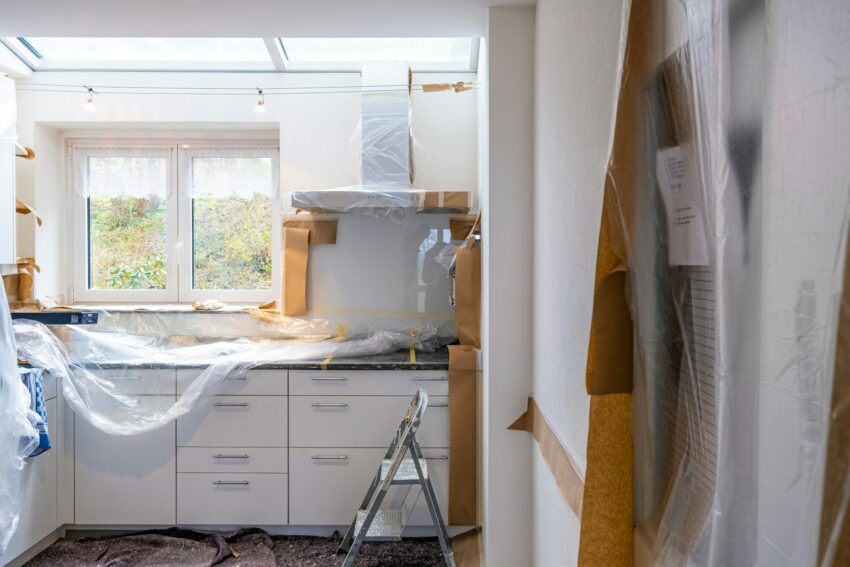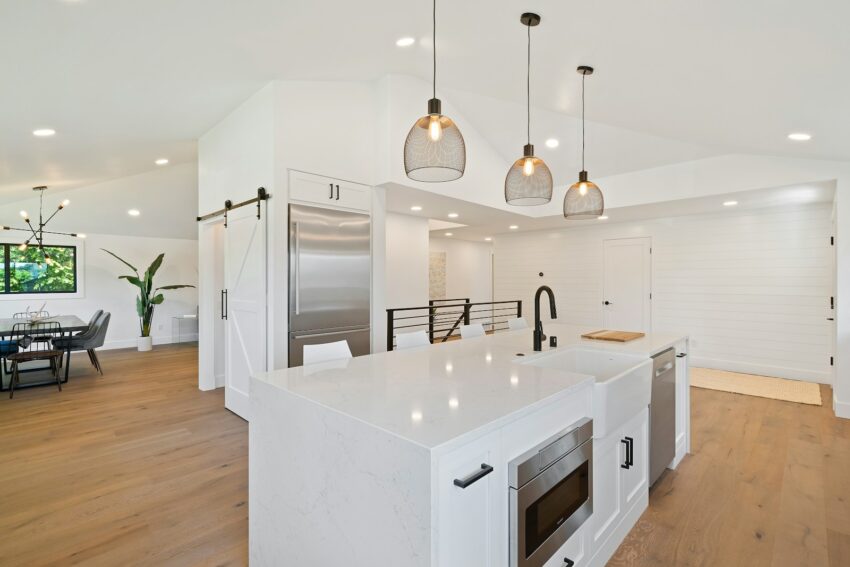How to renovate a house while living in it? It may sound challenging, but it’s entirely possible with the right planning and a few livability tricks. Surviving through a renovation can feel like trying to build a new home and live in it at the same time. Dust, noise, and clutter can quickly turn excitement into exhaustion, especially when moving out isn’t an option. Still, with smart organization, clear boundaries between living and work zones, and a few daily comforts, you can stay sane through the chaos.

This guide shares practical home renovation tips and simple ways to stay comfortable—from dust control and air quality to temporary housing during construction—so life keeps running smoothly until the final reveal.
Where to Live During Home Renovation: Decide Early and Be Realistic
First decision: stay or go? Not everyone has the option to leave, so if you must remain, think in terms of where to live during home renovation inside your own house. Choose the quietest, most contained area as your base and make it as self-sufficient as possible (sleeping, a working bathroom, and a mini kitchen). If you can briefly relocate some family members to friends, family, or short-term rentals, that can accelerate work and reduce cumulative stress; if relocation is impossible, prioritize containment, phased work, and a strict “no-go” zone for children and pets.
Practical options for temporary housing during construction include short-term rentals, extended-stay hotels, staying with friends or family, or living on-site in an RV or temporary trailer when local rules allow. All variants have privacy, cost, and convenience trade-offs. Some homeowners find it more cost-effective to pay a small accommodation fee to ensure faster completion and fewer overtime payments to the contractors.

Temporary Housing vs. Staying Home During Construction
If you’re debating between staying or leaving, evaluate your situation realistically:
- Cost: Compare rent or hotel rates to the extra contractor time when you’re home.
- Distance: Closer lodging makes site visits easier.
- Amenities: Access to laundry and a kitchen matters for longer stays.
- Local rules: Check if RVs or trailers are allowed on-site in your area.
If you choose to remain home, set clear “safe hours” when no work occurs. You’ll protect privacy and give your family time to rest from the constant activity.
Home Renovation Tips to Protect Daily Life
Here’s how to keep chaos under control when your home becomes a construction zone:
- Develop a short renovation strategy. Establish daily work windows, rules of access, staging areas, and emergency plans. Put the plan in writing and have each contractor and household member acknowledge it.
- Add a contingency. Allow at least 10–20% additional budget as a surprise. Damages or design alterations always emerge.
- Maintain one operational base zone. Keep your bedroom, working bathroom, and improvised kitchen clean to safeguard the routine of your family.
- Group messy work. Do the demolition, heavy dust work, and sanding simultaneously to schedule longer breaks between messy phases.
Small, thoughtful steps like these help you live normally throughout the process. Or at least as close to normal as possible.

Contain Dust and Keep the Air Breathable
Dust is the most frustrating part of living through a remodel. Thankfully, it’s manageable:
- Seal the work zone with plastic barriers and zipper doors.
- Create negative pressure by placing a box fan in a window and run a HEPA air purifier inside to reduce dust.
- Turn off your HVAC when demolition starts to prevent dust circulation.
- Wrap furniture and move fragile items to another room.
Ask your contractor to vacuum and sweep daily before leaving. The Spruce has an excellent step-by-step dust-control guide that can save your sanity and furniture.
Protect Your Mental Balance with Smart Noise and Schedule Management
One of the least discussed but most exhausting aspects of how to renovate a house while living in it is dealing with constant noise. Power tools, demolition, and hammering can disrupt sleep and focus, especially when working from home. Plan quiet windows for rest by negotiating work hours with your contractor. Use white noise machines or background music to reduce the perceived volume of construction sounds.
For small children or remote workers, consider temporary housing during construction days that involve heavy demolition or tile cutting. Even a weekend stay with relatives can provide a mental reset and keep your living space more peaceful overall.
Manage Waste and Daily Clean-Up Efficiently
Another underestimated part of home renovation tips is daily cleanup and safety. Designate one clear path for contractors to move materials and debris in and out, and lay down protective boards on the flooring. Keep an extra bin for recyclables and sharp waste to avoid accidents, and ensure your contractor uses a sealed dumpster instead of open piles that attract dust and pests. If possible, ask workers to tidy up at the end of each day so you can safely walk through your home at night without stepping over tools or cords. Simple cleanup agreements can dramatically improve livability and reduce renovation fatigue.
Learn How to Live During a Kitchen Remodel and Create an Effective Temporary Cooking Area
A kitchen remodel often feels like the hardest part of living through renovations. Keep your family fed and organized with these practical steps:
- Set up a temporary kitchen in a laundry room, basement, or spare bedroom. Include a mini-fridge, microwave, and portable cooktop.
- Stock up on simple, no-cook foods and quick-meal supplies.
- Use disposable plates and utensils for a few weeks to simplify cleanup.
- Plan at least one full week without your main appliances.
- Treat yourself to easy takeout nights when the stress hits.
You can use sites like Remodelaholic to find even more adaptable setups and get the basic idea of how to live during a kitchen remodel with maximum comfort.
Week-by-Week Survival Plan and Practical Checklist
A week-by-week plan helps you visualize progress and keep everyone accountable:
- Week 0 (Pre-Start): Finalize contracts, verify insurance, order long-lead materials, and move valuables off-site.
- Week 1 (Demo): Set containment barriers and test your temporary kitchen setup.
- Weeks 2-4 (Rough-ins): Expect daily noise and short water or power shutoffs.
- Weeks 5+ (Finishes): Clean between trades, inspect, and prepare your space for reset.
Safety, Kids, and Pets: Strict Rules to Keep Everyone Safe
Renovation sites are exciting for kids, but dangerous. Protect your family with a few rules:
- Mark construction zones as off-limits and close them with physical barriers.
- Keep pets away from dust and noise—crate them or ask a friend to pet-sit during the messiest weeks.
- Pack all tools, nails, and cords after each workday.
- Post safety reminders where kids can see them.
Preventing accidents keeps your project positive from start to finish.
Financial Tip: Plan for Surprises and Emergencies
When you cannot move out and funds are tight, every surprise risks extending the timeline and forcing you to live longer in disruption. Set aside an emergency fund, but also agree with your contractor on prioritizing work that restores livability first (bathrooms, a working kitchen, clear access paths).
If a short-term cash gap in the middle of a renovation risks a long delay, and there are no savings or credit-line alternatives, research options for covering unexpected home repair costs. Such fast solutions can be useful when the main priority is to finish the messy phases quickly and safely. Always include a clear repayment plan and treat short-term finance as a last-resort bridge, not a primary funding strategy.
Quick List of Questions to Ask Every Contractor
Before the quick checklist, remember: these questions are designed to protect both your quality of life during the project and your finances:
- Are you licensed and insured?
- What are your cleanup procedures?
- How do you manage dust containment?
- Who is the daily on-site contact?
- What’s the payment schedule?
Use these questions to spot contractors who will minimize disruption and hidden costs.
Make Temporary Living Feel Like Home
Even in chaos, comfort matters. Add soft lighting, throw blankets, and a rug to create a cozy “oasis” away from the noise. Keep at least one clean bathroom off-limits to workers. Schedule family outings or outdoor dinners to reset your mood when the mess becomes overwhelming.
If you need ideas, Young House Love shares plenty of family-friendly renovation stories that show how small comforts make a big difference during long projects.
Stay Focused on the Process to Get the Best Results
It is not very easy to live through a renovation, but with the proper plan, it is possible. Establish limits, negotiate with contractors, and plan for the unexpected. Whether you stay put or find temporary housing during construction, remember that each noisy, dusty day brings you closer to the dream home you envisioned.
Stay flexible, keep a sense of humor, and remember the beautiful result waiting beyond the dust.
